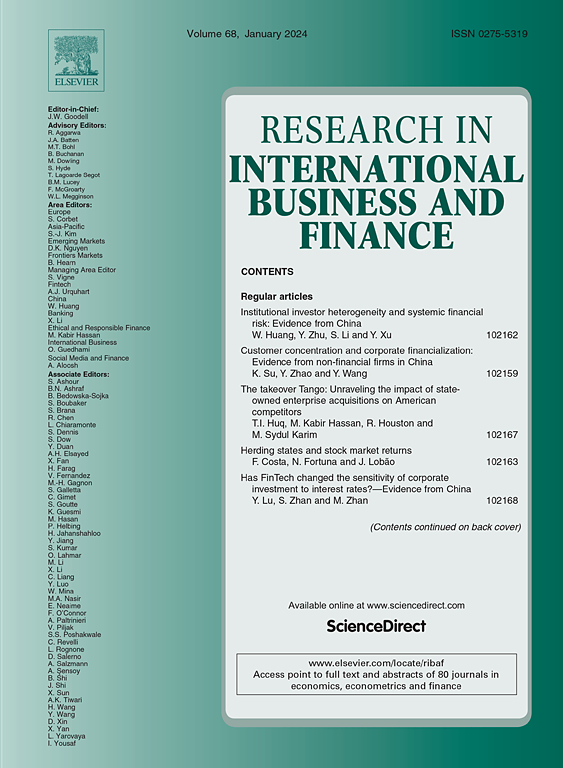How does liquidity regulation influence the effect of monetary policy transmission? A structural analysis based on the classified assets of chinese commercial banks
IF 6.3
2区 经济学
Q1 BUSINESS, FINANCE
Research in International Business and Finance
Pub Date : 2025-06-01
DOI:10.1016/j.ribaf.2025.102978
引用次数: 0
Abstract
The coordination between liquidity regulation and monetary policy is of great significance for the stability of financial markets. This study subdivides the credit assets of commercial banks, modifies the research framework based on the banks’ balance sheet, and uses theoretical modeling to depict the changes in the effect of monetary policy transmission to various classified assets of banks after introducing the Net Stable Funding Ratio (NSFR) constraint. Subsequently, using semi-annual data samples of Chinese commercial banks from 2015 to 2022, the paper empirically analyzes the impact of liquidity regulation on the asset structure and credit scale of commercial banks and the effect of monetary policy credit transmission. The research results show that: Firstly, liquidity regulation has a strong constraining effect on the expansion of the proportion of classified loans and the scale of credit, and it also affects the effect of monetary policy transmission. This effect gradually weakens and eventually becomes ineffective as the NSFR increases. Secondly, in order to meet liquidity regulation requirements, commercial banks generally adopt the approach of lowering the proportion of high-risk loans and increasing the holdings of securities, which is not only an important channel for regulatory policy to affect the overall effect of monetary policy transmission but also the main reason for the weakening of the aforementioned transmission effect. Finally, the impact of liquidity regulation on the effectiveness of monetary policy transmission is highly heterogeneous across bank ownership types, liquidity levels, and economic environments. When banks can effectively control the risk of certain credit assets, the effect of monetary policy transmission to such loans is enhanced, and liquidity regulation and monetary policy can achieve better coordination at this time.
流动性调控如何影响货币政策传导效果?基于我国商业银行分类资产的结构分析
流动性调控与货币政策的协调对金融市场的稳定具有重要意义。本研究对商业银行信贷资产进行细分,并基于银行资产负债表对研究框架进行修正,运用理论模型描述引入净稳定资金比率(NSFR)约束后货币政策传导对银行各类资产的影响变化。随后,利用2015 - 2022年中国商业银行半年度数据样本,实证分析流动性监管对商业银行资产结构和信贷规模的影响以及货币政策信贷传导的效果。研究结果表明:首先,流动性监管对分类贷款比例和信贷规模的扩张具有较强的约束作用,同时也影响货币政策传导的效果。随着NSFR的增加,这种作用逐渐减弱,最终失效。其次,商业银行为满足流动性监管要求,普遍采取降低高风险贷款比例、增持证券的方式,这既是监管政策影响货币政策传导整体效果的重要渠道,也是上述传导效果减弱的主要原因。最后,流动性监管对货币政策传导有效性的影响在银行所有权类型、流动性水平和经济环境中存在高度异质性。当银行能够有效控制某些信贷资产的风险时,货币政策对此类贷款的传导效果增强,流动性调控与货币政策在此时能够实现更好的协调。
本文章由计算机程序翻译,如有差异,请以英文原文为准。
求助全文
约1分钟内获得全文
求助全文
来源期刊

Research in International Business and Finance
BUSINESS, FINANCE-
CiteScore
11.20
自引率
9.20%
发文量
240
期刊介绍:
Research in International Business and Finance (RIBAF) seeks to consolidate its position as a premier scholarly vehicle of academic finance. The Journal publishes high quality, insightful, well-written papers that explore current and new issues in international finance. Papers that foster dialogue, innovation, and intellectual risk-taking in financial studies; as well as shed light on the interaction between finance and broader societal concerns are particularly appreciated. The Journal welcomes submissions that seek to expand the boundaries of academic finance and otherwise challenge the discipline. Papers studying finance using a variety of methodologies; as well as interdisciplinary studies will be considered for publication. Papers that examine topical issues using extensive international data sets are welcome. Single-country studies can also be considered for publication provided that they develop novel methodological and theoretical approaches or fall within the Journal''s priority themes. It is especially important that single-country studies communicate to the reader why the particular chosen country is especially relevant to the issue being investigated. [...] The scope of topics that are most interesting to RIBAF readers include the following: -Financial markets and institutions -Financial practices and sustainability -The impact of national culture on finance -The impact of formal and informal institutions on finance -Privatizations, public financing, and nonprofit issues in finance -Interdisciplinary financial studies -Finance and international development -International financial crises and regulation -Financialization studies -International financial integration and architecture -Behavioral aspects in finance -Consumer finance -Methodologies and conceptualization issues related to finance
 求助内容:
求助内容: 应助结果提醒方式:
应助结果提醒方式:


